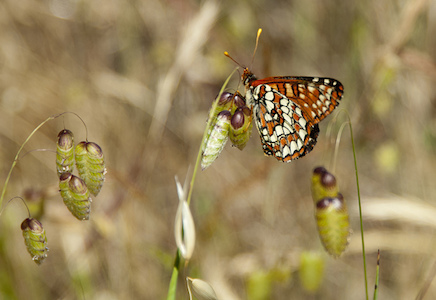Article
Vulnerability Assessments for California Species and Habitats
 |
Climate change vulnerability refers to the extent to which a species, habitat, or ecosystem process is susceptible to change as a result of climate change. Vulnerability assessments can help prioritize management action, develop management strategies to address climate change, and efficiently allocate resources. Below is a listing of important regional and sub-regional vulnerability assessments for California's species and habitats. Please see also this article: Resources for Conducting a Vulnerability Assessment |
| California's Water Resources | California Dept. of Water Resources | California Water Plan Update 2013, Chapter 5: Managing an Uncertain Future | This chapter of the CA Water Plan Update 2013 presents water management scenarios, vulnerabilities, and a framework to measure the sustainability of water management policies and projects. |
| California Vegetation | UC Davis and California Dept. of Fish & Wildlife | A climate change vulnerability assessment of California’s terrestrial vegetation | This report presents the results of a climate vulnerability analysis of the terrestrial vegetation of California. Vegetation was assessed at the macrogroup level, consistent with the conservation targets presented in the 2015 State Wildlife Action Plan, and supportive of the state’s efforts to employ an ecosystem-based approach to conservation. |
| North-central Coastal Species and Habitats | Gulf of the Farallones National Marine Sanctuary, CA LCC | Climate Change Vulnerability Assessment for the North-central California Coast and Ocean | Assessed climate change vulnerability of 44 focal resources of the North-central Coastal region, including eight habitats, populations of 31 species, and five ecosystem services |
| Central Valley Rangelands | USGS Western Geographic Science Center, CA LCC | Threat Assessments for California Rangelands | Created maps of three main rangeland ecosystem services—wildlife habitat, water supply, and carbon sequestration. An interactive website lets users view changes across scenarios and years. |
| Sierra Nevada Meadows | Conservation Science Partners and the USFS Pacific Southwest Region | Decision support for meadow conservation and restoration in the Sierra Nevada Ecoregion | Still in progress, this CA LCC-funded project is assessing climate change vulnerability of Sierra Nevada meadows and prioritizing meadows for restoration. |
| Central Valley Habitats, Species Groups, and Species | EcoAdapt, CA LCC | Central Valley Vulnerability Assessments | Climate change vulnerability assessments for the Central Valley Landscape Conservation Project's Priority Natural Resources. These are being used to develop landscape-scale adaptation strategies and actions. |
| California Fish | UC Davis Center for Watershed Sciences and Department of Wildlife Fish and Conservation Biology | Projected Effects of Future Climates on Freshwater Fishes of California | Systematic evaluation of climate change impacts on freshwater fishes in California (121 native fish taxa and 43 aliens). |
| California Amphibians, Reptiles, Birds, and Mammals | California Department of Fish and Wildlife | A Rapid Assessment of the Vulnerability of Sensitive Wildlife to Extreme Drought | The historically unprecedented severity of the recent drought and concern for the impact it might have on rare and endangered species led the Department to conduct a rapid assessment of vertebrate taxa most likely to be vulnerable to the effects of extreme, prolonged drought. |
| California Amphibians and Reptiles | California Department of Fish and Wildlife | California Amphibian and Reptile Species of Future Concern: Conservation and Climate Change | Ecological niche models for all 153 reptile and amphibian species in California were built using Maxent to forecast the distribution of climatically suitable habitat under four future climate scenarios and eleven general circulation models for 2050. Risk was measured as both the percentage of currently occupied localities remaining suitable in the future, and the change in suitable area. |
| Sierra Nevada Species | EcoAdapt, CA LCC | Vulnerability Assessment and Adaptation Strategies for Focal Resources of the Sierra Nevada | Assessed vulnerabilities of 8 Sierra ecosystems, 15 species, and 4 ecosystem services |
| Sierra Nevada Birds | Rodney Siegel, The Institute for Bird Populations, CA LCC | A Climate Change Adaptation Strategy for Sierra Nevada Birds | Used the NatureServe Climate Change Vulnerability Index tool to assess vulnerability of 140 bird species of the Sierra Nevada and develop an adaptation strategy. |
| California Birds | Gardali, et. al. | A Climate Change Vulnerability Assessment of California's At-Risk Birds | Ranked 358 avian taxa, and classified 128 as vulnerable to climate change. |
| California Rare Plants | Schoenig and Anaker, Calif. Dept. of Fish & Wildlife, CA LCC | Assessing and Mapping Rare Plant Species Vulnerability to Climate Change | Assessment of species vulnerability to climate change and mapping occurrences and distribution of those believed to be most vulnerable in California. |
| Coastal Southern California Habitats | EcoAdapt, CA LCC | Vulnerability Assessments and Adaptation Strategies for Coastal Southern California Habitats | Vulnerability assessments, climate-smart adaptation strategies and actions, and implementation plans for focal habitats of the South and Central Coast regions of California with a specific focus on four Southern California National Forests (Angeles, San Bernardino, Cleveland, Los Padres). Includes case studies of key climate change adaptation conservation actions. |
Subjects:
Geographic Keywords:
Last Updated:
7/2017
